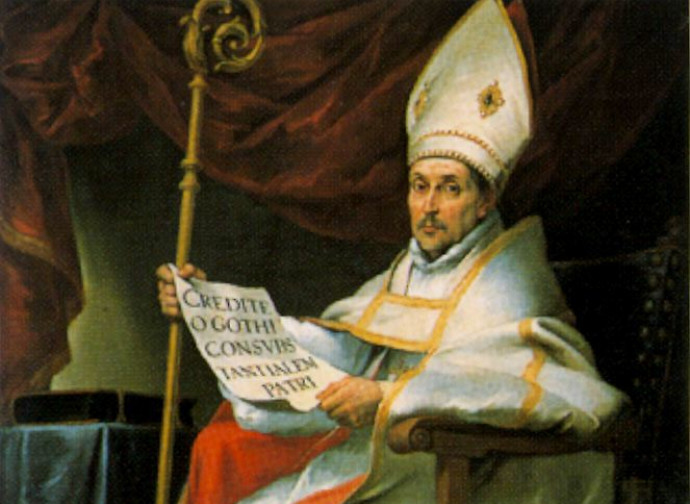Saint Leander of Seville
Elder brother of three saints, among whom the best known is Isidore of Seville, Saint Leander (c. 534-599) is remembered above all for the role he played in the conversion of the Visigoth royal family from Arianism, which reigned over Spain at that time.

Elder brother of three saints, among whom the best known is Isidore of Seville, Saint Leander (c. 534-599) is remembered above all for the role he played in the conversion of the Visigoth royal family from Arianism, which reigned over Spain at that time. He was the first of five children of a noble Roman family from Cartagena and, after the untimely death of his father, took care of his siblings Florentina, Fulgentius, Isidore and Theodosia. With the exception of the latter, all his siblings dedicated themselves to the religious life and are venerated by the Church. Florentina became a Benedictine nun and founded numerous monasteries. Fulgentius was appointed Bishop of Astigi (today's Écija), while Isidore, proclaimed Doctor of the Church, was Leander’s successor at the head of the Archdiocese of Seville and became famous in the Middle Ages for his encyclopaedic work Etymologies, which, at the dawn of the third millennium, led a group of people to propose him as patron saint of the Internet.
Leander began his religious life as a Benedictine monk and around 578 he became Archbishop of Seville. Here he met Hermenegild, married to the very young Catholic Ingonda, and son of Leovigildus, Visigoth king of Aryan faith. The Catholicism professed by Ingonda (whom Leovigildo's second wife had attempted with violence to convert to Arianism) was the reason why Hermenegild and his wife were expelled from the court of Toledo: in 580, to avoid other problems, his father sent him to Seville to rule Betica (now Andalusia), a province that bordered with the lands occupied by the Byzantines.
Hermenegild’s conversion to the Nicene Creed, baptized by Saint Leander himself, created turmoil throughout the province and several cities proclaimed him king. This gave rise to a conflict with his father, who defeated him, exiled him to Valencia and then to Tarragona, where he was entrusted to the surveillance of Duke Sigebert. During his imprisonment, Hermenegild undertook various penances and prayed to God to free him from those sufferings. On April 13, 585, after refusing to receive the host from an Aryan who had been sent by his father, he was murdered by Sigebert. Later he was canonised by the Church, which venerates him as a martyr. Leander had meanwhile lived three years in exile in Constantinople - where he made friends with the future Pope Gregory the Great, who was there as pontifical delegate - and subsequently in North Africa.
Saint Leander was recalled to Spain only in 586, on the death of Leovigildo, who was succeeded to the throne by his son Recaredo. The new king put an end to the persecution of Catholics and the following year he converted, initiating a process of religious unification of his kingdom which culminated in the Third Council of Toledo, begun on 8 May 589 and organised at the instigation of Recaredo himself, of whom Saint Gregory would say: “It is no wonder that he became a preacher of the true faith, because his brother was a martyr, whose merits helped him to bring many souls back to God”. At the Council, the Visigoth sovereign solemnly professed the Catholic faith, and Leander delivered a famous homily (Homilia de triumpho Ecclesiae ob conversionem Gothorum), in which he said, “New peoples were suddenly born for the Church. Those who previously made us suffer with their harshness now console us with their Faith”.




